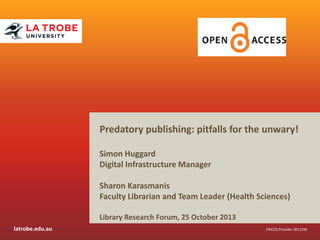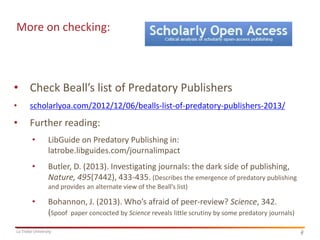Predatory publishing: pitfalls for the unwary. 25 Oct 2013
- 1. Predatory publishing: pitfalls for the unwary! Simon Huggard Digital Infrastructure Manager Sharon Karasmanis Faculty Librarian and Team Leader (Health Sciences) Library Research Forum, 25 October 2013 latrobe.edu.au CRICOS Provider 00115M
- 2. Predatory Publishers: ŌĆó Gold Open Access Model has created opportunities for corrupt publishers to flourish ŌĆó Open Access mandates have spawned more of these recently, with a huge increase in reports of questionable email requests ŌĆó Only exist to extract author processing fees (often only charging when the manuscript accepted) ŌĆó Take advantage of authors who want to publish in Open Access journals, note: new PhD graduates targeted! La Trobe University 2 2
- 3. Predatory publishers ŌĆō some characteristics: ŌĆó Look convincing by using similar names to well known publications (eg. IJCEE: International Journal of Civil & Environemental Engineering vs International Journal of Environmental Engineering ;SciMed Central vs Pubmed Central) ŌĆó Websites littered with grammatical errors ŌĆó No peer-review process or bogus reviewer details ŌĆó Spam researchers, soliciting manuscripts but failing to mention required author fee. After the paper is published, authors are invoiced typically US$1,800 ŌĆó List bogus contact details (tricky to spot!) La Trobe University 3 3
- 4. How can you check? ŌĆó Look for publishers verifiable contact details, be cautious if only a web form is provided! ŌĆó Does the editorial board list recognised experts with affiliations ŌĆó Check that author fees are prominently displayed ŌĆó Be wary of email invitations ŌĆó Read previous papers and assess the quality ŌĆó Check peer-review process is clearly described, try to confirm if the displayed impact factor is correct! La Trobe University 4 4
- 5. More on checking: ŌĆó Check BeallŌĆÖs list of Predatory Publishers ŌĆó scholarlyoa.com/2012/12/06/bealls-list-of-predatory-publishers-2013/ ŌĆó Further reading: ŌĆó LibGuide on Predatory Publishing in: latrobe.libguides.com/journalimpact ŌĆó Butler, D. (2013). Investigating journals: the dark side of publishing, Nature, 495(7442), 433-435. (Describes the emergence of predatory publishing and provides an alternate view of the BeallŌĆÖs list) ŌĆó Bohannon, J. (2013). WhoŌĆÖs afraid of peer-review? Science, 342. (Spoof paper concocted by Science reveals little scrutiny by some predatory journals) La Trobe University 5 5
- 6. Consider Green Open Access! ŌĆó Upload a submitted manuscript or postprint of your article to Research Online (LTU research repository) ŌĆó Article will be available freely online ŌĆó No article processing fees ŌĆó Contact repository@latrobe.edu.au La Trobe University 6 6
- 7. One example: La Trobe University 7 7
- 9. Predatory/bogus publishers La Trobe University 9 9
- 10. Where to Publish: Evaluating journals ŌĆó What are the main issues? ŌĆó Publishing in high impact scholarly journals ŌĆó Selecting journals relevant to your discipline ŌĆó Where are other experts in your discipline publishing? ŌĆó Identifying a journal in consideration of ERA, FoR codes and impact factors ŌĆó Ensuring your research is reaching relevant audiences La Trobe University 10 10
- 11. What quality factors should I look for? ŌĆó Use a range of criteria and compare with other journals in the same category ŌĆó Quantitative and qualitative assessments such as: ŌĆó Journal impact factors ŌĆó Indexing and abstracting services ŌĆó Relevance to your discipline ŌĆó Ranking within your discipline ŌĆó Peer review process La Trobe University 11 11
- 12. A range of Library resources are available: (under Databases Tab) ŌĆó Journal Citation Reports (JCR) ŌĆó Eigenfactor calculation ŌĆó Scopus Journal Analyzer (SJR) ŌĆó SCImago (uses SJR data) ŌĆó InCites ŌĆó Further guidance available: ŌĆó latrobe.libguides.com/journalimpact La Trobe University 12 12
- 13. ŌĆó Contact your Faculty Librarian ŌĆó latrobe.edu.au/library/contact-us ŌĆó Research Education and Development (RED) ŌĆó latrobe.edu.au/research/red ŌĆó Research Services ŌĆó latrobe.edu.au/research-services La Trobe University 13 13













